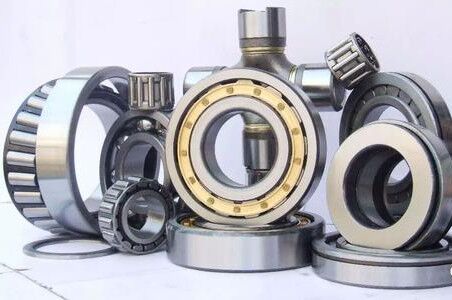Rolling bearing materials include materials for rolling bearing parts and cages, rivets and other auxiliary materials.
Rolling bearings and their parts are mostly made of steel. Rolling bearing steels are usually high-carbon chromium steel and carburized steel. With the development of modern science and technology and the increasing use of rolling bearings, the requirements for bearings are getting higher and higher, such as high precision, long life and high reliability. For some special-purpose bearings, the bearing material is also required to have the properties of high temperature resistance, corrosion resistance, non-magnetic, ultra-low temperature, and radiation resistance. In addition, bearing materials also include alloy materials, non-ferrous metals and non-metallic materials. In addition, bearings made of ceramic materials are now used in locomotives, automobiles, subways, aviation, aerospace, chemical and other fields.
The basic requirements of rolling bearings for materials depend to a large extent on the working performance of the bearing. Whether the choice of materials for rolling bearings is appropriate will have a great impact on its performance and life. In general, the main failure forms of rolling bearings are fatigue spalling under the action of alternating stress, and loss of bearing accuracy due to friction and wear. In addition, there are also cracks, indentations, rust and other reasons that cause abnormal damage to the bearing. Therefore, rolling bearings should have high resistance to plastic deformation, less friction and wear, good rotation accuracy, good dimensional accuracy and stability, and long contact fatigue life. And many of the properties are determined by materials and heat treatment processes.
Since the basic requirements for materials of rolling bearings are determined by the form of damage of the bearings, the materials required to manufacture rolling bearings should have the following properties after a certain heat treatment in the subsequent process:
a High contact fatigue strength
Contact fatigue failure is the main form of normal bearing failure. When the rolling bearing is in operation, the rolling elements roll between the raceways of the inner and outer rings of the bearing, and the contact part bears periodic alternating loads, which can reach hundreds of thousands of times per minute. Under the repeated action of periodic alternating stress, the contact surface Fatigue peeling occurs. When the rolling bearing starts to peel off, it will cause bearing vibration and noise increase, and the working temperature will rise sharply, causing the bearing to be damaged. This type of damage is called contact fatigue damage. Therefore, the steel for rolling bearings is required to have high contact fatigue strength.
b High abrasion resistance
When the rolling bearing works normally, in addition to rolling friction, it is also accompanied by sliding friction. The main parts of sliding friction are: the contact surface between the rolling element and the raceway, the contact surface between the rolling element and the cage pocket, between the cage and the ring guide rib, and the roller end surface and the ring guide Wait between the sidewalls. The existence of sliding friction in rolling bearings inevitably causes wear of bearing parts. If the wear resistance of the bearing steel is poor, the rolling bearing will lose its accuracy prematurely due to wear or decrease the rotation accuracy, which will increase the vibration of the bearing and reduce its life. Therefore, the bearing steel is required to have high wear resistance.
c high elastic limit
When the rolling bearing is working, because the contact area between the rolling element and the raceway of the ring is small, the contact pressure of the contact surface is very large when the bearing is under load, especially under the condition of large load. In order to prevent excessive plastic deformation under high contact stress, loss of bearing accuracy or surface cracks, the bearing steel is required to have a high elastic limit.
d Appropriate hardness
Hardness is one of the important indicators of rolling bearings. It has a close relationship with material contact fatigue strength, wear resistance, and elastic limit, and directly affects the life of rolling bearings. The hardness of the bearing is usually determined by the overall situation of the bearing load mode and size, bearing size and wall thickness. The hardness of the rolling bearing steel should be appropriate, too large or too small will affect the service life of the bearing. As we all know, the main failure modes of rolling bearings are contact fatigue damage and loss of bearing accuracy due to poor wear resistance or dimensional instability; if the bearing parts lack a certain degree of toughness, they will be caused by brittle fracture when subjected to large impact loads. Destruction of the bearing. Therefore, the hardness of the bearing must be determined according to the specific situation of the bearing and the way of damage. For the loss of bearing accuracy due to fatigue spalling or poor wear resistance, higher hardness should be selected for bearing parts; for bearings subject to larger impact loads (such as rolling mills: bearings, railway bearings and some automotive bearings, etc.), they should be appropriately reduced Hardness is necessary to improve the toughness of the bearing.
e certain impact toughness
Many rolling bearings will be subjected to a certain impact load during use, so the bearing steel is required to have a certain degree of toughness to ensure that the bearing is not damaged due to impact. For bearings that withstand large impact loads, such as rolling mill bearings, railway bearings, etc., materials are required to have relatively high impact toughness and fracture toughness. Some of these bearings use bainite quenching heat treatment process, and some use carburized steel materials. Ensure that these bearings have better impact resistance and toughness.
f Good dimensional stability
Rolling bearings are precision mechanical parts, and their accuracy is calculated in micrometers. In the process of long-term storage and use, changes in the internal organization or changes in stress will cause the bearing size to change, causing the bearing to lose accuracy. Therefore, in order to ensure the dimensional accuracy of the bearing, the bearing steel should have good dimensional stability.
g Good anti-rust performance
Rolling bearings have many production processes and a long production cycle. Some semi-finished or finished parts need to be stored for a long time before assembly. Therefore, bearing parts are prone to a certain degree of corrosion during the production process or in the storage of finished products. It is in humid air. Therefore, the bearing steel is required to have good rust resistance.
h Good process performance
In the production process of rolling bearings, its parts have to go through multiple cold and hot processing procedures. This requires that the bearing steel should have good process properties, such as cold and hot forming properties, cutting, grinding performance and heat treatment performance, etc., to meet the needs of rolling bearing mass, high efficiency, low cost and high quality production.
In addition, for bearings used under special working conditions, in addition to the above-mentioned basic requirements, corresponding special performance requirements must be put forward for the steel used, such as high temperature resistance, high speed performance, corrosion resistance and antimagnetic performance.
Post time: Mar-26-2021

